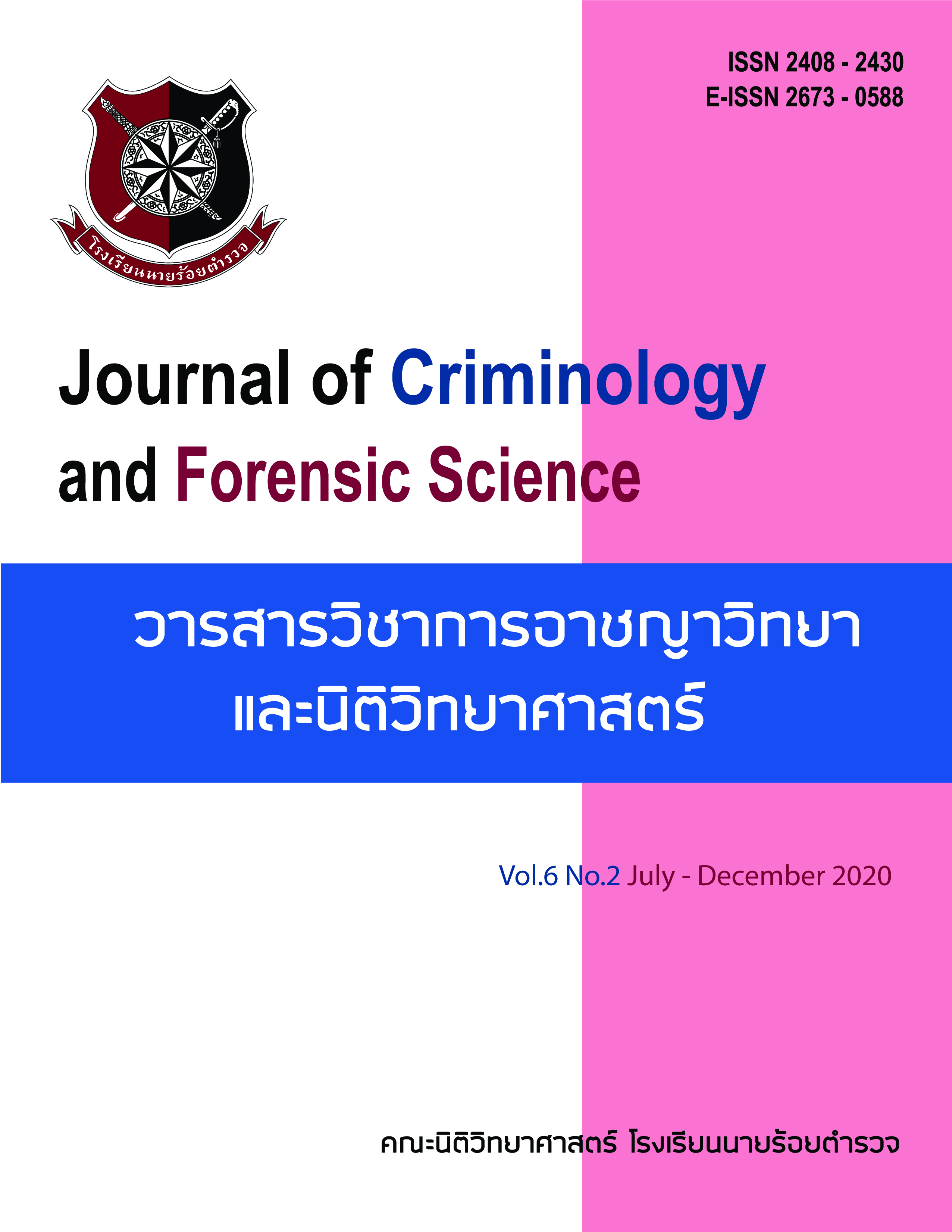เทคโนโลยีแฮชชิ่งและฐานข้อมูลโฟโต้ดีเอ็นเอในการตรวจพิสูจน์สื่อมัลติมีเดีย
Main Article Content
บทคัดย่อ
สื่อมัลติมีเดียมีความสำคัญในการตรวจพิสูจน์การกระทำความผิดมากยิ่งขึ้น โดยเฉพาะอย่างยิ่งอาชญากรรมล่วงละเมิดต่อเด็กซึ่งมีการรับส่งรูปภาพและสื่อที่มีเนื้อหารุนแรงทางเพศเพิ่มขึ้นทุกวันผ่านผู้ให้บริการสื่อสังคมออนไลน์ ทั้งนี้ เทคโนโลยีแฮชมีบทบาทสำคัญในการสืบค้นและคัดกรองไฟล์ดิจิทัล โดยค่าแฮชแบบไบนารีเป็นผลการคำนวณฟังก์ชันแบบเดิมที่ตรวจสอบความมั่นคงและความครบถ้วนสมบูรณ์ของไฟล์ ส่วนค่าแฮชรูปภาพแบบทนทานเป็นรูปแบบการคำนวณผลลัพธ์ทางคณิตศาสตร์แบบใหม่ซึ่งกำลังได้รับความนิยมในปัจจุบันในตรวจวัดความคล้ายของรูปภาพ โดยตำรวจ หน่วยงานบังคับใช้กฎหมาย องค์กรไม่แสวงหากำไร ผู้ให้บริการอินเทอร์เน็ต และสื่อสังคมออนไลน์ได้ร่วมกันพัฒนาเทคโนโลยีในการตรวจจับและคัดกรองเนื้อหาที่มีความรุนแรงทางเพศต่อเด็กและเยาวชน โดยฐานข้อมูลแฮชที่จัดบัญชีรายการค่าแฮชทั้งแบบทั่วไปและแบบโฟโต้ดีเอ็นเอถูกแบ่งปันไปยังหน่วยงานตำรวจเพื่อใช้สำหรับการตรวจวิเคราะห์ไฟล์สื่อลามกอนาจารที่ปรากฏในพยานหลักฐานอิเล็กทรอนิกส์ อย่างไรก็ตาม การเลือกใช้เครื่องมือตรวจพิสูจน์หลักฐานดิจิทัลควรพิจารณาให้รองรับกับการสืบค้นด้วยเทคโนโลยีแฮชที่ครอบคลุมทั้งแบบไบนารีและแบบทนทาน
Article Details
เนื้อหาและข้อมูลในบทความที่ลงตีพิมพ์ใน วารสารวิชาการอาชญาวิทยาและนิติวิทยาศาสตร์ โรงเรียนนายร้อยตำรวจ ถิอว่าเป็นข้อคิดเห็นและความรั้บผิดชอบของผู้เขียนบทความโดยตรงซึ่งกองบรรณาธิการวารสาร ไม่จำเป็นต้องเห็นด้วยหรือรับผิดชอบใดๆ
บทความ ข้อมูล เนื้อหา รูปภาพ ฯลฯ ที่ได้รับการตีพิมพ์ใน วารสารวิชาการอาชญาวิทยาและนิติวิทยาศาสตร์ ถือว่าเป็นลิขสิทธิ์ของวารสาร วารสารวิชาการอาชญาวิทยาและนิติวิทยาศาสตร์ หากบุคคลหรือหน่วยงานใดต้องการนำทั้งหมดหรือส่วนหนึ่งส่วนใดไปเผยแพร่ต่อหรือเพื่อกระทำการใดๆ จะต้องได้รับอนุญาตเป็นลายลักษณ์อักษรจาก วารสารวิชาการอาชญาวิทยาและนิติวิทยาศาสตร์ ก่อนเท่านั้น
เอกสารอ้างอิง
INTERPOL & ECPAT. (2018). Towards a Global Indicator on Unidentified Victims in Child Sexual Exploitation Material: Summary Report. Bangkok: ECPAT International.
INTERPOL & ECPAT. (2018). Towards a Global Indicator on Unidentified Victims in Child Sexual Exploitation Material: Technical Report. Bangkok: ECPAT International.
Saetang, W. & Boonkrong, S. (2017). Effectiveness Analysis and Hash Function. Journal of Food Health & Bioenvironmental Science. 10(2), 81-94. (In Thai)
Nadeem, M. S., Franqueira, V. N., Xiaojun Zhai, Wei Ren, Wang, L., Choo, K.-K. R., & Xhafa, F. (2019). Privacy verification of PhotoDNA based on machine learning. In Security and Privacy for Big Data, Cloud Computing and Applications. https://doi.org/10.1049/pbpc028e_ch12
Chinpanthana, N. (2017). A Study of Low-Level Feature Extraction Techniques Used for Content-Based Image Retrieval System. Christian University Journal. 23(1), 130-139. (In Thai)
Farid, H. (2018). Reining in Online Abuses. Technology & Innovation. https://doi.org/10.21300/19.3.2018.593
Jusas, V., Birvinskas, D., & Gahramanov, E. (2017). Methods and tools of digital triage in forensic context: Survey and future directions. In Symmetry. https://doi.org/10.3390/sym9040049
Tang, Z., Zhang, X., Li, X., & Zhang, S. (2016). Robust Image Hashing with Ring Partition and Invariant Vector Distance. IEEE Transactions on Information Forensics and Security, 11(1), 200–214. https://doi.org/10.1109/TIFS.2015.2485163
NetClean Technologies. (2019). NetClean Report 2019: A Report about Child Sexual Abuse Crime. From https://www.netclean.com/wp-content/uploads/sites/2/2017/06/Netclean_report_2019_spread.pdf
Singh, P., & Farid, H. (2019). Robust Homomorphic Image Hashing. In CVPR Workshops (pp. 11-18).
Tunyasevee, W., & Witchuwanich, W. (2019). A Comparative Evaluation of Open Source and Commercial Tools for Digital Forensics. In Journal of Criminology and Forensic Science, 5(2), 42-57. (In Thai)


